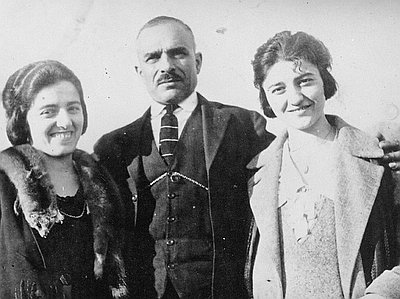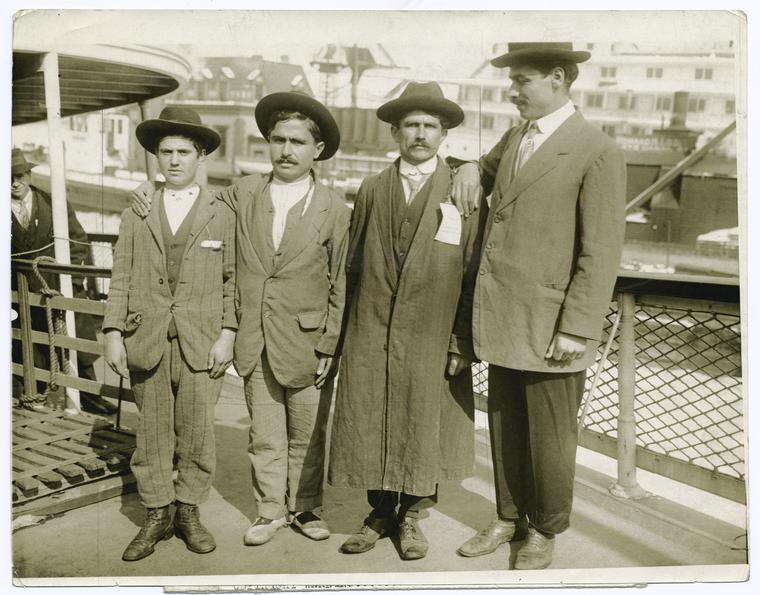How Armenian-Americans Became White: A Brief History
On Christmas Eve 1909, four Ottoman-born Armenian men received an auspicious gift from a circuit judge in Boston. Jacob Halladjian, Mkrtich Ekmekjian, Avak Mouradian, and Basar Bayentz had petitioned for citizenship in the face of government opposition and won. A small headline wedged into the congested third page of The New York Times unceremoniously announced their legal triumph to the world the next morning: “Citizenship for Armenians.”

Though the brief article was likely of minimal import for most people who picked up a copy of The Times that Saturday, the historical consequences of the case proved momentous. Judge Francis C. Lowell hadn’t simply deemed four immigrants eligible for naturalization; he bestowed upon Armenians the juridical distinction of whiteness for the first time.
A few months later, Congress codified Lowell’s decision, decreeing that Armenians, along with Assyrians and Jews, were exceptions to the rule that so-called “Asiatics” were ineligible for naturalization.
Although whiteness would not receive a somewhat positive legal definition until 1924 – a Virginia anti-miscegenation law defined whites as those who have either “no trace whatsoever of any blood other than Caucasian” or “one-sixteenth or less of the blood of the American Indian and have no other non-Caucasic blood” – naturalization was restricted to white persons by the Naturalization Act of 1790. This provision stayed in place until the enactment of the Immigration and Nationality Act of 1952, though there were frequent changes to the requirements in between.
Because of the malleability and general instability of racial categories, Armenians were able to take advantage of the blurry boundaries of whiteness, going from potential members of the “yellow race” to white persons eligible for naturalization.
Despite the ruling in favor of the four Armenians, one of the arguments in the 1909 case laid bare that their classification as white was far from set in stone. Along with scientific racism, “popular knowledge” was often used as a justification for including or excluding people from the elusive racial category, especially in the early twentieth century. This hardly-definitive criterium was on full display in the Halladjian decision; the brief issued by the United States contended that “without being able to define a white person, the average man in the street understands distinctly what it means.” Furthermore, the proverbial average man would ostensibly “find no difficulty in assigning to the yellow race a Turk or Syrian with as much ease as he would bestow that designation on a Chinaman or a Korean.”
The judge dismissed this argument on the grounds that skin color alone was not a useful indicator of whiteness, adding that the four men – all of whom hailed from cities within the modern-day borders of the Republic of Turkey – would, in appearance, “pass undistinguished in western Europe.” The court even went so far as to reject the notion that certain racial categories existed in the first place, finding that “there is no European or white race, as the United States contends, and no Asiatic or yellow race which includes substantially all the peoples of Asia.” Nevertheless, the judge ruled that, if the “ordinary classification” was followed, Armenians had always “been reckoned as… white persons.”
Regardless of the decision, the fact that representatives of the United States relied on flimsy, racialist logic in a court of law carried some weight. Whether intentional or not, the state gave credence to the notion that something as unreliable as a typical person’s supposed perception of race was enough to potentially bar an entire group of people from the benefits of naturalization. The court’s finding that the racial categories upon which American naturalization law rested did not exist only worked to compound the uncertainty.
As such, Armenians’ legal status as white persons was not firmly secured by In re Halladjian. It would take a second court case, this time in Oregon, to put the matter to bed.
In 1923 Tatos Cartozian, a resident of the United States of nearly twenty years, applied for citizenship and received provisional approval after physically presenting himself to the court for “visual scrutiny” – in other words so the judge could ensure his skin was the proper tinge of white. Not long thereafter, the attorney general’s office filed a suit to revoke his newly-granted certificate of naturalization, alleging that the rug merchant was not a “free white person.” Cartozian was going to court.

The resulting case, United States v. Cartozian, lasted until the summer of 1925. District Judge Charles E. Wolverton, a Theodore Roosevelt appointee, was tasked with determining whether Cartozian qualified as a free white person as outlined in the eighteenth-century Naturalization Act. Like Lowell before him, Wolverton stated that skin color was not a practical litmus test for ascertaining citizenship eligibility, but resolved that “it may be confidently affirmed” that Armenians are white persons, basing his conclusion in part on the belief that they “readily amalgamate with the European and white races.”
Citing Herodotus and Strabo to bolster the claim that “Armenians are of the Alpine stock” along with expert witness and noted anthropologist Franz Boas’ assertion that “it would be utterly impossible to classify [Armenians] as not belonging to the white race,” Wolverton dismissed the bill of complaint. The state, just as it had sixteen years earlier in Massachusetts, found itself on the losing end; Armenians’ claim to whiteness had been reaffirmed.
The first quarter of the twentieth century saw Armenians go from “Asiatics,” at least in the eyes of the state, to legal white persons. Doubtless, the difference was palpable. Four years after Halladjian, California had passed its alien land law, which denied the right to own, lease, or “otherwise enjoy” land to people ineligible for citizenship, giving Armenians the edge on some of their fellow immigrants. Over time, this access to land ownership and housing loans allowed many Armenians to become relatively wealthy farmers in places like Fresno County, California.
Structural advantages notwithstanding, Armenians were still unable to assimilate completely. Fresno, a hub for Armenian immigrants in the 1890s and early 1900s, serves as a representative example here as well. While Armenians quickly established themselves as a sizeable minority in the city, many Fresnans considered them to be non-white and treated them accordingly. They faced exclusion from social activities and discrimination in landowning and employment, and were even excluded from a Protestant church they helped establish.
Armenians were also vilified for being stereotypically thievish and dishonest. Adults and children alike regularly faced racial invectives such as “dirty black Armenian,” “low-class Jew,” and – most commonly – “Fresno Indian.” American-born author William Saroyan, a Pulitzer Prize and Academy Award winner who was certainly no stranger to mainstream American culture, wrote in one of his many memoirs that “Armenians were considered inferior” and were “hated” in his hometown. In the same work, he recounts an episode from his childhood in which one of his schoolteachers told him it was rude to speak a foreign language in class, saying, “this is America, now.” The prolific writer apparently thought, even in his young age, that the teacher openly disliked Armenian children. To make matters worse, Fresnan Armenians had to deal with more institutional modes of discrimination as well, such as restrictive housing covenants in the city that lasted until the middle of the twentieth century.

While some of these conditions persist to the present day as part of a broader culture of nativism and xenophobia endemic to the United States, they now come in large part without demonstrable socioeconomic consequences. Today Armenian Americans, on the whole, enjoy high levels of wealth relative to many non-whites, an observable trend more attributable to Armenians’ racial position – which is but one of many inextricable demographic factors such as occupation, educational attainment, etc. – than their fabled proclivity for hard work. In 2015, per capita income in the United States was an estimated $29,979. For Armenians, that figure was $36,644, more than double that of people the Census Bureau recorded as “Hispanic or Latino (of any race),” about 80 percent more than that of “Blacks or African Americans,” and just slightly greater than the number reported for “Asians.” If these statistics are any indication, Armenians have achieved a degree of social mobility that has never been attainable for the Black and brown classes of America.
About four hundred years ago, an Armenian servant to the colonial governor of Virginia reached Jamestown, possibly the same year the first Africans – Kimbundu and Kikongo speakers from the Angola-Congo regions – in English America were transported to the same settlement by pirates in 1619 and sold into bondage. It would not be until the late 1800s, however, that Armenians began arriving to the United States in significant numbers, thus marking the beginning of their fraught relationship with the country’s particular racial regime.
Despite considerable improvements in the community’s material conditions over time, this relationship is no less complex now than it was during the legal drama of the last century. As whiteness itself is continually being defined and redefined by ever-shifting frontiers, so too is the racial position of the hundreds of thousands of Armenians living in contemporary America. Though the margins of whiteness remain a site of fierce contention, at least one thing is certain: the lines of demarcation are just as ambiguous today as they were on that December day in 1909.

Aram Ghoogasian -- Ajam Media Collective
Aram Ghoogasian is a teacher and writer from Los Angeles. His work has appeared in several publications, including The New York Times, Armenian Weekly, and The Daily Bruin.
Ajam Media Collective: This article was written by a guest contributor and solely reflects the views of the author.
